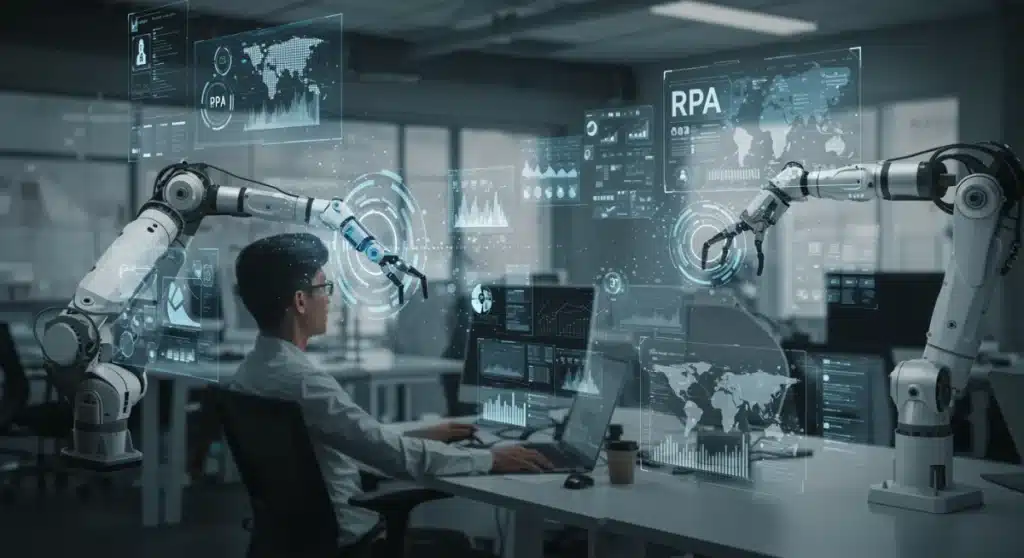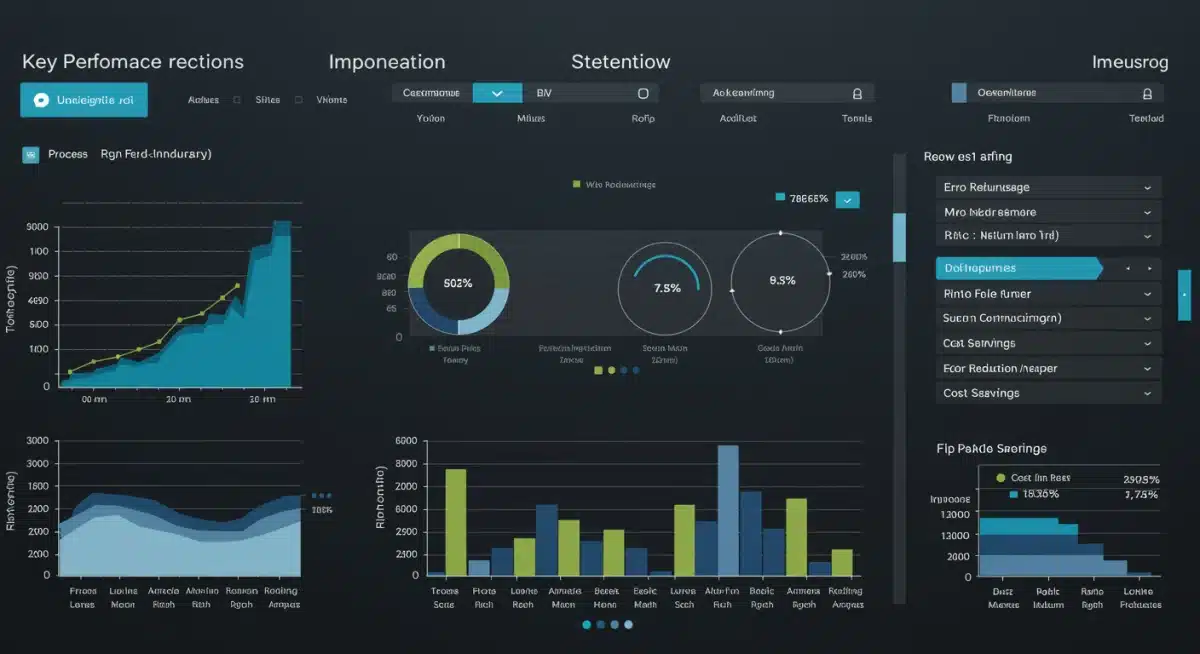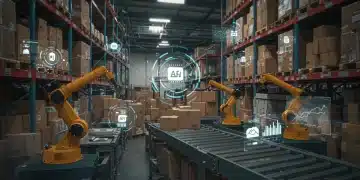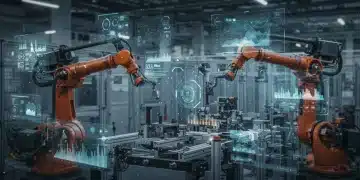RPA Trends 2025: Streamlining Operations, 10% Labor Cost Savings

Robotic Process Automation (RPA) Trends for 2025 are rapidly evolving, enabling businesses to streamline operations and achieve labor cost reductions of up to 10% through intelligent automation.
As of late 2024, the landscape of business automation is undergoing a significant transformation. The latest insights confirm that Robotic Process Automation (RPA) Trends for 2025: Streamlining Operations and Saving 10% on Labor Costs are not just predictions but are becoming immediate realities for organizations globally. This shift promises enhanced efficiency and substantial financial benefits. What exactly are these pivotal trends, and how will they reshape the operational methodologies of businesses in the coming year?
The Rise of Hyperautomation and AI Integration
The convergence of Robotic Process Automation (RPA) with Artificial Intelligence (AI) and Machine Learning (ML) is defining the next generation of automation. This trend, often referred to as hyperautomation, moves beyond simple task execution to encompass intelligent process orchestration and decision-making. Businesses are now leveraging AI to make RPA solutions more adaptive and capable of handling complex, unstructured data.
Hyperautomation is enabling organizations to automate not just repetitive, rule-based tasks but also processes that require cognitive abilities. This integration allows RPA bots to learn from data, adapt to changing conditions, and even predict outcomes, leading to more robust and resilient automated workflows. Early adopters are reporting significant gains in operational speed and accuracy.
Key Components of Hyperautomation
- Intelligent Document Processing (IDP): AI-powered solutions extract and process information from various document types, including invoices and contracts.
- Process Mining: Tools analyze existing business processes to identify bottlenecks and optimal automation opportunities.
- Machine Learning Models: Embedded ML allows bots to learn from historical data, improving decision-making and task execution over time.
Enhanced Employee Experience and Co-Bot Deployments
While often perceived as a tool for cost reduction, RPA is increasingly being recognized for its potential to improve the employee experience. By offloading mundane, repetitive tasks, RPA allows human workers to focus on more strategic, creative, and fulfilling activities. This shift is leading to higher job satisfaction and better utilization of human capital.
The concept of ‘co-bots’ – collaborative robots – is gaining traction. These are RPA bots designed to work hand-in-hand with human employees, assisting them with tasks rather than replacing them entirely. This collaborative approach fosters a synergistic environment where the strengths of both humans and automation are maximized. Companies are finding that this approach not only boosts productivity but also enhances employee morale and engagement.
Focus on End-to-End Process Automation
Initially, RPA implementations often targeted isolated departmental tasks. However, the current trend for 2025 is a strategic shift towards end-to-end process automation. Businesses are now looking to automate entire workflows that span multiple departments and systems, from customer onboarding to supply chain management. This holistic approach ensures maximum efficiency and eliminates manual handoffs that can introduce errors and delays.
Achieving true end-to-end automation requires careful planning and a deep understanding of interconnected business processes. It often involves integrating RPA with other enterprise systems like ERP, CRM, and bespoke applications. The goal is to create a seamless digital thread that automates the entire lifecycle of a business process, from initiation to completion, without human intervention.
Benefits of End-to-End Automation
- Reduced Cycle Times: Processes complete significantly faster, leading to quicker service delivery and improved customer satisfaction.
- Improved Data Accuracy: Eliminates manual data entry and transfers, drastically reducing human error rates.
- Greater Transparency: Automated workflows provide clear audit trails and real-time visibility into process status.
- Scalability: Automated processes can be scaled up or down rapidly to meet fluctuating business demands.
The Drive for Measurable ROI and Cost Reduction
A primary driver behind the accelerated adoption of RPA Trends for 2025: Streamlining Operations and Saving 10% on Labor Costs is the undeniable focus on measurable Return on Investment (ROI). Organizations are no longer just experimenting with RPA; they are demanding clear, quantifiable financial benefits. The promise of significant labor cost savings – often cited around 10% or more for optimized processes – is a major catalyst.
To achieve these savings, businesses are implementing robust governance frameworks and performance metrics to track the impact of RPA initiatives. This includes monitoring bot utilization, error rates, processing times, and the direct cost savings realized from reduced manual effort. The emphasis is on identifying processes with high transactional volumes and repetitive steps, where automation can deliver the quickest and most substantial returns.
Companies are also exploring different deployment models, such as RPA-as-a-Service (RPAaaS), to reduce upfront investment and accelerate time-to-value. This allows businesses to scale their automation efforts more flexibly and align costs directly with usage, making RPA accessible to a broader range of organizations, including small and medium-sized enterprises (SMEs).
Democratization of RPA and Citizen Development
The push for widespread RPA adoption is leading to the democratization of automation tools. Low-code and no-code RPA platforms are empowering ‘citizen developers’ – business users with little to no coding experience – to build and deploy their own automation solutions. This trend significantly expands the pool of individuals who can contribute to automation initiatives, accelerating digital transformation across the enterprise.
Citizen development platforms typically offer intuitive drag-and-drop interfaces and pre-built templates, making it easier for departmental users to automate their daily tasks. This approach not only speeds up automation deployment but also ensures that solutions are closely aligned with actual business needs, as they are developed by the people who understand the processes best. This trend is vital for achieving pervasive automation.
Security, Governance, and Scalability as Core Pillars
As RPA deployments become more extensive and critical to business operations, the focus on security, governance, and scalability is intensifying. Organizations recognize that robust automation requires a strong foundation of secure practices and well-defined operational frameworks. Data privacy, compliance with regulations like GDPR and CCPA, and secure access management are paramount concerns for RPA initiatives.
Effective governance ensures that RPA bots operate within established policies, maintain data integrity, and adhere to compliance standards. This includes clear roles and responsibilities, change management processes, and comprehensive auditing capabilities. Scalability is also a key consideration; solutions must be designed to expand effortlessly across the enterprise without compromising performance or security. Businesses are investing in centralized RPA platforms that offer enterprise-grade security and management features.

| Key Trend | Brief Description |
|---|---|
| Hyperautomation & AI | RPA combines with AI/ML for intelligent, adaptive process automation, handling complex data. |
| End-to-End Automation | Shift from task-specific bots to comprehensive automation of entire business workflows across departments. |
| Cost Reduction Focus | Strong emphasis on achieving measurable ROI and labor cost savings, targeting 10% or more. |
| Citizen Development | Low-code/no-code platforms empower business users to build and deploy their own automation solutions. |
Frequently Asked Questions about RPA Trends in 2025
The primary goal is to achieve significant operational streamlining and measurable labor cost savings, often targeting a 10% reduction. This is accomplished by automating repetitive tasks, freeing up human resources for higher-value activities, and enhancing overall business efficiency.
AI’s integration with RPA, known as hyperautomation, allows bots to handle more complex tasks, process unstructured data, and make intelligent decisions. This moves RPA beyond simple rule-based automation, making it more adaptive and powerful for diverse business processes.
Yes, by automating mundane and repetitive tasks, RPA frees employees to focus on more strategic, creative, and engaging work. This shift can lead to increased job satisfaction, reduced burnout, and a more fulfilling work environment for human staff.
Citizen development refers to empowering business users, who lack formal coding skills, to create and deploy automation solutions using low-code/no-code RPA platforms. This democratizes automation, accelerating its adoption and ensuring solutions align closely with specific business needs.
Governance is crucial for ensuring RPA bots operate securely, comply with regulations, and maintain data integrity. It involves establishing clear policies, roles, and auditing capabilities to manage and scale automation efforts effectively across the enterprise, minimizing risks.
What Happens Next
The rapid evolution of RPA, particularly its convergence with AI and the strategic shift towards end-to-end automation, signals a new era for business operations. Companies not embracing these RPA Trends for 2025: Streamlining Operations and Saving 10% on Labor Costs risk falling behind competitors who are actively leveraging automation for efficiency and competitive advantage. We anticipate continued innovation in AI-driven RPA solutions and an even greater focus on measuring tangible ROI in the coming months, as organizations further refine their automation strategies.





